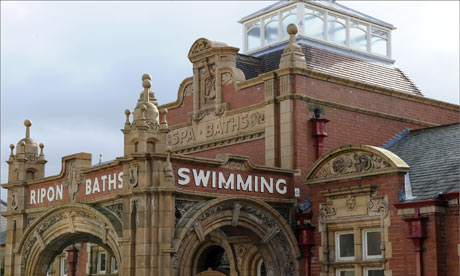
The popularity of swimming has soared in the UK following the success of the British team in last year's Beijing Olympics, yet much of our swimming heritage is endangered, with dozens of pre-war public baths under threat of closure due to renovation costs. But a new book celebrating the splendour of these historic buildings hopes to raise awareness of the fight to keep them open.
Great Lengths, which is published tomorrow, profiles the evolution of public baths from the Victorian era through their golden age in Edwardian times and up to today, with new pools such as the London Aquatics Centre, which is set to be the architectural highpoint of the 2012 Olympics.
"I have enormous sympathies for local authorities that have historic baths," says the book's co-author, Simon Inglis. "Camden [north London] is putting £22m into the baths at Kentish Town, yet you can build a new 25-metre pool for £10m."
"But an older pool offers a sense of intimacy, continuity and community. One only has to swim in one of the smaller pools, such as Bramley in Leeds, with its arched stained glass windows. Its like the difference between an old Victorian pub and a modern wine bar."
Moreover, Inglis says, these baths are a significant part of Britain's industrial and imperial heritage. "Britain was the first industrialised nation to provide public baths since the Romans," he says. "The Victorians saw themselves as the new Romans. The grandeur of the fittings harked back to Roman ideals of splendour. It was a way for local authorities to show off their civic might. They were also a showcase for British industry."
"We might look on these baths as very old-fashioned now, but they were cutting edge at the time in terms of the piping, tiling, glasswork and boilers, which was all British made. We have this legacy of wonderful historic buildings, which we have to be careful we don't squander because we were the world leaders in public baths."
Part of the problem for councils with pre-war pools is that the original design reflected a much more segregated society, with first-, second- and even third-class pools in the same building, and different baths for men and women.
"The first-class pool water was changed more often and the fittings were superior," Inglis explains. "The idea was that you didn't have to swim with the opposite sex or in the same water as your staff or servants."
Mixed swimming sessions were first introduced in the Edwardian era, but it was not until the 1930s that the design of public baths was desegregated.
Inglis says: "Interestingly, there is now a return to segregation, with calls in Muslim areas and by young women to have single-sex swimming, so in that respect we have come full circle."
• View a gallery of Britains historic pools at SocietyGuardian.co.uk/communities

